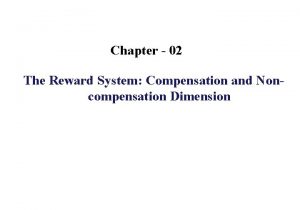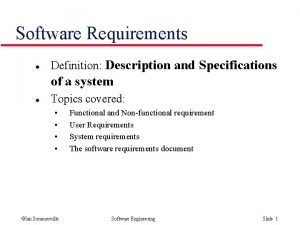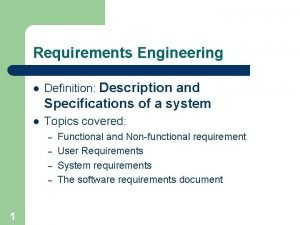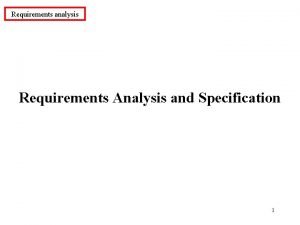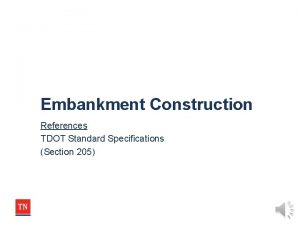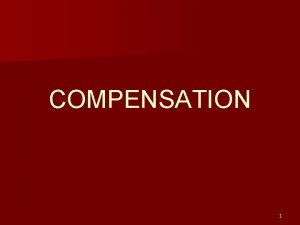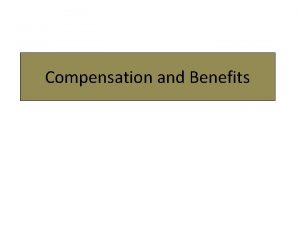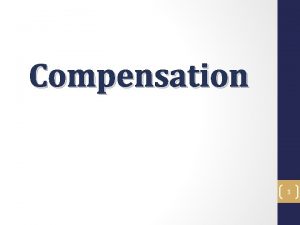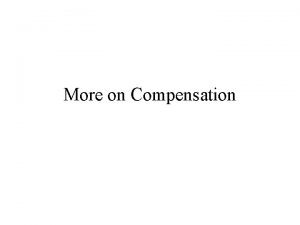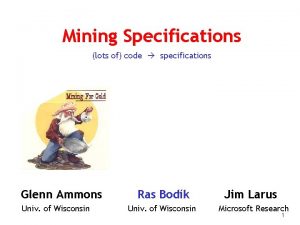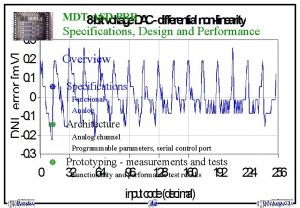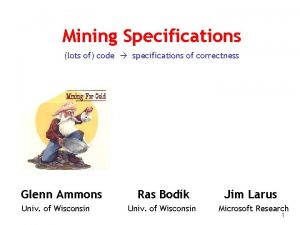Management Compensation 1 Introduction to Management Compensation Specifications































- Slides: 31

Management Compensation 1

Introduction to Management Compensation Specifications of managerial work very difficult to describe – various types of task on day to day bases internal role directing an organizational unit (leadership) external role developing relationships outside the organization 2

Levels of management Managerial compensation follows the hierarchical structure of an organization Top management 1 -5 % of the organization’s workforce Developing goals and strategies to keep the organization effective Concerned with the problems extending years in the future Responsible for the total operation (CEO and executive VPs) the owners through the board of directors see them as the trustees of their sources their compensation is connected with the success of the organization as a whole as well as their own indeed, it has been found that managerial system which did not focus on critical organization outcomes were ineffective (Schuster, Management Compensation) 3

Levels of management Lower management first – line mangers = supervise the work of non-managerial employees compensated as a percentage of wage of the people they supervise Middle management a larger number of managers information channel between top managers and supervisors specific function in the organization and coordinate other functions in the organization compensation related to the function being managed, managerial surveys decrease over the past years in order to reduce bureaucracy 4

Difference between 'Management' and 'Executive' Management group Executive group exists within the management group “top”, “president”, “vice-president”, “chief” differentiated position within the organization In many international locations and within small to medium-sized North American firms, the terms „managers“ and „executives“ are used interchangeably However 5

Difference between 'Management' and 'Executive' in U. S large publicly traded corporations two separate spheres Executive body Management Body 6

Components of managerial compensation base pay, bonuses (short term incentives), capital appreciation plans (long term incentives), deferred compensation and benefits (including perquisites/perks). 7

Aspects of compensation plans commitment managers associate themselves with the organization difficult to turn off the job even in their leisure time decision making core of managerial work particularly broad framework of decision-making under uncertainty primarily conceptual decision-making orientation power needs focus on getting the job done in the organization enjoy controlling a situation and having a strong influence on the outcome of events the idea of status managers spend an enormous amount of time at work have heavy responsibility 8

Other ways to determine the level of pay Management by objective based on individual definition of performance measurable standards are developed by the manager himself and his supervisor performance is evaluated towards the objectives at the end of a period by both parties jointly drawbacks hold managers to the objective that are out of date in case the world is too dynamic 9

Other ways to determine the level of pay Pay for performance It has been found that the perception would lead to higher pay is more important than the fact Generally, there is nearly no relation between pay and performance with managers measured from a sample of 600 middle- and lower-level managers. However, those who were the most highly motivated felt that pay was important to them and that good performance would lead to higher wage In many cases it is hard for the managers to see the connection between performance and pay rewards are deferred the goals are not clearly expressed It cannot be taken for granted that paying for performance is worth doing 1 0

Bonus standards – short term incentives a manager receives a bonus because some standard was met in the past period organizational (productivity, cost saving) job related (job outcomes, performance of particular activities) usually paid in cash based upon the base pay of the managers e. g. assume that the organization wished to maintain a minimum return on assets of 10 percent. The managers may receive 20 percent of base pay if the organization achieves a 10 percent return on assets and an additional 5 percent of base pay for each 5 percent increase in return on assets over 10 percent. 1 1

Long term incentives – stock options Is used to tie the managers to the long term success of the organization primarily motivates top management granting managers the right to become a part of shareholders ownership and control come closer together 1 2

Stock Option Possibilities Stock Option Plan managers are offered stock at a set price Stock Appreciation Rights (SAR) work like stock options but the managers do not have to buy the stock the manager receives from the organization the difference between the current market value of the stock and the stated option value of the stock however, the amount of possible gain is limited 1 3

Stock Option Possibilities Restricted stock plans the manager is granted a certain number of shares of stock as a bonus but may not sell those shares until certain conditions have been met (such as certain performance, employment for certain years) Phantom Stock plans In these plans the manager is awarded units that represent shares of stock. These units typically mature at some time, ordinarily four to six years. At maturity the manager is paid then-current value of the stock or the difference between the original value and current value. 1 4

Stock Option Possibilities Performance share plans the manager is granted performance units that represent shares of common stock. He or she earns these shares through the performance of the organization. 1 5

Issues with stock options Managers may be inclined to inflate the value of the company so as to inflate the value of their stocks options. Enron Apple Computer World. Com Global Crossing 1 6

Deferred compensation Retirement benefits Golden parachutes provides pay and benefits to an executive after being terminated due to a merger or acquisition reasons for doing so limit the risk of unforeseen events business expenses Perks designed to satisfy special needs of the managers, especially top managers may include a car, entertainment expenses, and club memberships. services such as free medical examinations, low-cost loans, and financial or legal counseling 1 7

Interesting note: Pay rises in all circumstances The CEO is truly underpaid. The consultant reports this to the Compensation Committee, and the executive's salary is increased. The CEO is not underpaid and the company is doing well. The consultant is asked to compare the executive's salary to a set of companies who are known to pay highly. The result is a recommendation to raise the executive's pay. The CEO is not underpaid and the company is not doing well. The consultant finds management lamenting that with these low wages, turnover is inevitable. The consultant then suggests a raise to prevent turnover. 1 8

Executive pay compared to blue-collar workers in the U. S. A. Source: Business Week 1 9

Differences in the pay of managers and blue collar workers explained 5 Motivational models: 1. The equity model if the manager is earning such high salary, his contribution should be equally great contradictions 2. The performance-motivation model questions whether it is the manager or other environmental factors that lead to results of the company 2 0

Differences in the pay of managers and blue collar workers explained 3. Agency theory managers – agents of the stockholders in the general assumption, interest of the shareholders and managers are the same, but in practice not. Shareholders thus attempt to align the interest of top management with their own by designing attractive compensation packages 4. Tournament theory promotion is viewed as tournament and the high pay is the price of winning 2 1

Differences in the pay of managers and blue collar workers explained 5. Social comparison theory people need to evaluate themselves in comparison to others thus managers of one company must be paid similarly to managers of another 2 2

How is pay established? Board of Directors = Compensation Committee 2 3

Executive compensation The compensation of every employee is decided by the company owners through the board of directors and the management team (or "management committee"). There may be a 'personnel and compensation committee' that deals specifically with labour compensation. Employee compensation may be negotiated with a workers union. Management team compensation is often left to the company. 2 4

Executive compensation Five tools of compensation: base salary short-term incentives long-term incentives (LTIP) employee benefits Perquisites In a typical modern US corporation, the CEO and other top executives are paid salary plus short-term incentives or bonuses. 2 5

Management compensation Chevron management committee example: The purpose of the Management Compensation Committee of the Board of Directors of Chevron Corporation is: 1. To discharge the responsibilities of the Board of Directors of the Corporation relating to compensation of the Corporation’s executives; 2. To assist the Board of Directors in establishing the appropriate incentive compensation and equity-based plans and to administer such plans; 3. To produce an annual report on executive compensation for inclusion in the Corporation’s annual proxy statement; and 4. To perform such other duties and responsibilities enumerated in and consistent with this Charter. 2 6

Mitigating the Principal-Agent problem Managers have strong incentives to gamble on risky projects that impose potentially large losses on the firm's fixed claim holders. Moral hazard : investment-risk choices made by management are not readily observable by depositors and regulators 3 4

Firms response to threat by: Altering top-management compensation as a way of influencing managerial return and risk-taking incentive Bank lenders may impose measures (such as imposing more restrictive loan covenants) to protect their investments in troubled firms. Senior managers' compensation may be tied to the successful resolution of the firm's bankruptcy or debt restructuring, or is based on the value of payoffs to creditors. From “CEO Compensation in Financially Distressed Firms: An Empirical Analysis” pg 456 3 5

Firms response to threat by: Replacing top managers: One-third of top management may be replaced in a given year around default, and those who remain often take substantial cuts in their salary and bonus. Average inside replacement CEO earned 35% less than his or her predecessor. Average outside replacement CEO earned 36% more than the CEO he or she replaced. Outside replacement CEOs, who represent almost 60% of new CEO hires, also typically receive large grants of stock options as part of their compensation (to turn the company around). 3 6

Firms response to threat by: Deferred compensation: Deferring part of the managements compensation until the firm's financial restructuring was completed. reduces legal fees and other costs that increase directly with the amount of time that firms spend renegotiating their debt contracts. firms respond to financial distress by basing more of senior managers' compensation on longterm stock-based performance measures, cuts in their cash compensation (including bonuses). 3 7

Concluding remarks The components of managerial compensation are: base pay, bonuses (short term incentives), capital appreciation plans (long term incentives), deferred compensation and benefits (including perquisites/perks). Principal – Agent Problems can be mitigated through a variety of methods 3 8
 Compensation and non compensation dimensions
Compensation and non compensation dimensions Drawing up test specifications
Drawing up test specifications Mla format specifications
Mla format specifications Tdot standard specifications
Tdot standard specifications Apwa standards
Apwa standards System requirements document
System requirements document Domain requirements examples
Domain requirements examples Form-based specifications
Form-based specifications Application specifications
Application specifications Packaging quality assurance
Packaging quality assurance Site:slidetodoc.com
Site:slidetodoc.com Nao robot specifications
Nao robot specifications Boxn wagon dimensions
Boxn wagon dimensions Geofoam tiered seating
Geofoam tiered seating Tdot standard specifications
Tdot standard specifications Steel truss thickness
Steel truss thickness Caltrans 2010 standard specifications
Caltrans 2010 standard specifications Direct motion specification is
Direct motion specification is Specifications and constraints
Specifications and constraints Spot weld symbol
Spot weld symbol Jayco sterling 2010 brochure
Jayco sterling 2010 brochure Use case specifications
Use case specifications Functional view specification in iot
Functional view specification in iot Transmisi rantai
Transmisi rantai Matt looney
Matt looney Typical primary coil resistance specifications
Typical primary coil resistance specifications Edifact specifications
Edifact specifications Characteristics of ideal and practical op amp
Characteristics of ideal and practical op amp Process specification structured decisions
Process specification structured decisions A goal of producing process specifications is to:
A goal of producing process specifications is to: A goal of producing process specifications is to:
A goal of producing process specifications is to: Amba specifications
Amba specifications
